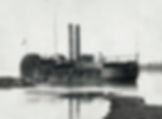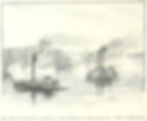The Timberclads
- Mike at SBS
- Dec 19, 2021
- 5 min read

When the American Civil War began in 1861, the US Navy was charged with executing the famous Anaconda Plan, which aimed to strangle the Confederacy by securing all the waterways and coastlines from rebel shipping. At the time, the navy was rather ill-equipped to complete this mission, but a crash program to convert civilian steamers into gunboats started to make up the numbers of ships, boats, and steamers required for the task. On the Mississippi River, the federal government purchased three steamers and converted them into low-draft gunboats for river patrol work. They were stripped of their upper works, reinforced by thick oak planking, and armed with several heavy naval guns. They were then commissioned the USS Tyler, Lexington, and Conestoga.


Above: USS Tyler
The three gunboats were jokingly referred to as "timberclads", in contrast to the cutting edge "ironclads" that were starting to be built at the same time. While the ironclad fleets slowly came off the ways, the three timberclads carried the full weight of naval operations in the early months of the war and provided critical gun support, escort, and raiding support. The Tyler and Lexington fought their first major battle was to support Grant at Belmont, Missouri on 7 November 1861. The two timberclads engaged Confederate artillery and covered Grant's withdrawal from the inconclusive battle.

After Belmont, the Tyler and Lexington were joined by the Conestoga and all three steamed to support the Union ironclads' attack and capture on Fort Henry on the Tennessee River on 6 February 1862. While the ironclad fleet steamed to the Cumberland River to fight in the much more difficult battle of Fort Donelson, Flag Officer Andrew Hull Foote ordered the three timberclads to launch a raid down the Tennessee as far as possible, destroying Confederate supplies. The three timberclads were placed under the command of Lt. Seth Ledyard Phelps and steamed up the Tennessee as far as the Mussels Shoals in northern Alabama before the river became unnavigable.

Above: Battle of Fort Henry
After their raid, the timberclads would support Union riverine operations, interdict southern shipping, and raid enemy supply depots along the Mississippi's northern tributaries. On 6 April 1862, the Tyler and Lexington supported Grant again at Pittsburgh Landing, helping to stiffen the crumbling Union lines at the Battle of Shiloh. The gunboats' heavy guns broke the southern assault that nearly destroyed Grant's army on the bank of the Tennessee.

Above: The Lexington and Tyler at the Battle of Shiloh
When the Union focus shifted to the Mississippi itself more and more vessels were deployed on the river to support the land forces there. However, as the Union presence grew, so too did the defensive capabilities of the confederates and soon the banks were well defended by forts, ram vessels, and gunboats. As a result, the Union leaned heavily on its ironclad fleet and a new emerging ship type known as "tinclads". These ships were lightly armored to withstand bullet fire and sent to patrol the rivers already in Union hands to fight partisans and raid Confederate supplies. The timberclads then took on a support role for the ironclads, participating in the operations around Vicksburg, on the Yazoo, White, and Red Rivers.

On once such patrol, on 15 July 1862, the USS Tyler accompanied the USS Carondelet and US Ram Queen of the West on the Yazoo River in search of the infamous Confederate ironclad, CSS Arkansas, rumored to be nearing completion. In fact, the rebel ram was fully operational and met the small union squadron, severely damaging the ironclad Carondelet and chasing off the Queen and Tyler.

Above: USS Conestoga
From March to May 1864, the Lexington joined the Union fleet in support of the ill-fated Red River Campaign in northern Louisiana. After the campaign crumbled and the Union forces retreated, the Lexington nearly got trapped with the rest of the Union fleet when the river's lowering water level exposed a waterfall at Alexandria, Louisiana. A genius plan was concocted to build a series of dams to build up the water needed to float the fleet over the waterfall and then breach the dam to release water the vessels one by one to safety. The Lexington shot through the resulting rapids in a spectacular fashion. Luckily the rest of the Union fleet was also able to escape.

Both the Lexington and Tyler survived the war and were decommissioned and sold at auction to civilian operators. However, the Conestoga was accidentally rammed by the USS General Price on 8 March 1864 and sank.
Lexington or Conestoga?
There is a bit of controversy about which timberclad is which in photos and sketches of the period. In particular there is a confusion between the USS Lexington and USS Conestoga. At some point a photo of the Conestoga was mislabeled the Lexington, and from that point on the mistake has been further distributed.

Above: The Conestoga/Lexington confusion perhaps started here. This is most certainly not the Conestoga and is more likely the Lexington or Tyler.
Many photos of the Lexington show that the boat has its smoke stacks well forward, while others show them amidships. So which one is correct? Let’s have a look at a few images from the Lex’s career.
Both the USS Tyler and the USS Lexington provided heavy gun support at a critical point in the Battle of Shiloh, helping to turn the tide of the battle. The third timberclad, USS Conestoga, was not present at the battle. Here’s a period rendition of the boats as they supported the army at Pittsburgh Landing.

Above: Tyler and Lexington at Shiloh, 6 April 1862
Here is another famous photo of the Lexington during the 1864 Red River Campaign. The Lexington was the only one of the three timberclads on the Red River (the Tyler patrolling elsewhere and the Conestoga having being sunk earlier on the Mississippi River).

Above: This photo was taken on the Red River Campaign, sometime between March and May 1864. The Lexington was the only timberclad on the campaign.
And let's not forget that epic wartime illustration of the Lexington slipping through the dams on the Red River!

Finally, we have the testimony of her sailing-master, Lt Jacob Hurd. In August 1861 Hurd described the Lexington for an article in the Chicago Tribune, “The chimneys are close together, nearly amidships, piercing the boiler deck immediately forward of the quarterdeck. The pilothouse stands forward of the chimneys and is bulletproof.”
Therefore, the gunboat with its stacks at the fore cannot be the Lexington. Nor can it be the Tyler as evident of this photo that was proudly autographed by her commanding officer in 1863, Lt James Prichett:

Furthermore, the Tyler is well documented, as opposed to the Lexington and Conestoga, so we can be reasonably confident when we identify the Tyler. Like with the Lex, the Tyler’s stacks are placed amidships. So, that leaves the USS Conestoga as the gunboat with the stacks far forward.

Above: Apart from the pilot house being placed forward the stacks, this is a reasonably accurate engraving of the Conestoga (left) and the Lexington (right)
The last piece of the puzzle is to be able to spot the difference between the Tyler and the Lexington. Simply put, the aft deck is longer behind the paddlewheels on the Lexington than they are on the Tyler. Furthermore, some photos and illustrations show the Tyler with a white stripe painted along her gun ports.

Above: USS Conestoga
So that solves the mystery of the mixed-up photos. Photos and illustrations of the gunboats with their stacks amidships are the Tyler and Lexington. The boat with the stacks well forward is the Conestoga.

Further Reading
I would highly recommend The Timberclads in the Civil War: The Lexington, Conestoga and Tyler on the Western Waters, by Myron J. Smith, Jr. The book is an excellent and exhaustive resource about these three remarkable ships. Incidentally, Smith has some other excellent books that really dig into the previously obscure aspects of Civil War riverine warfare.

